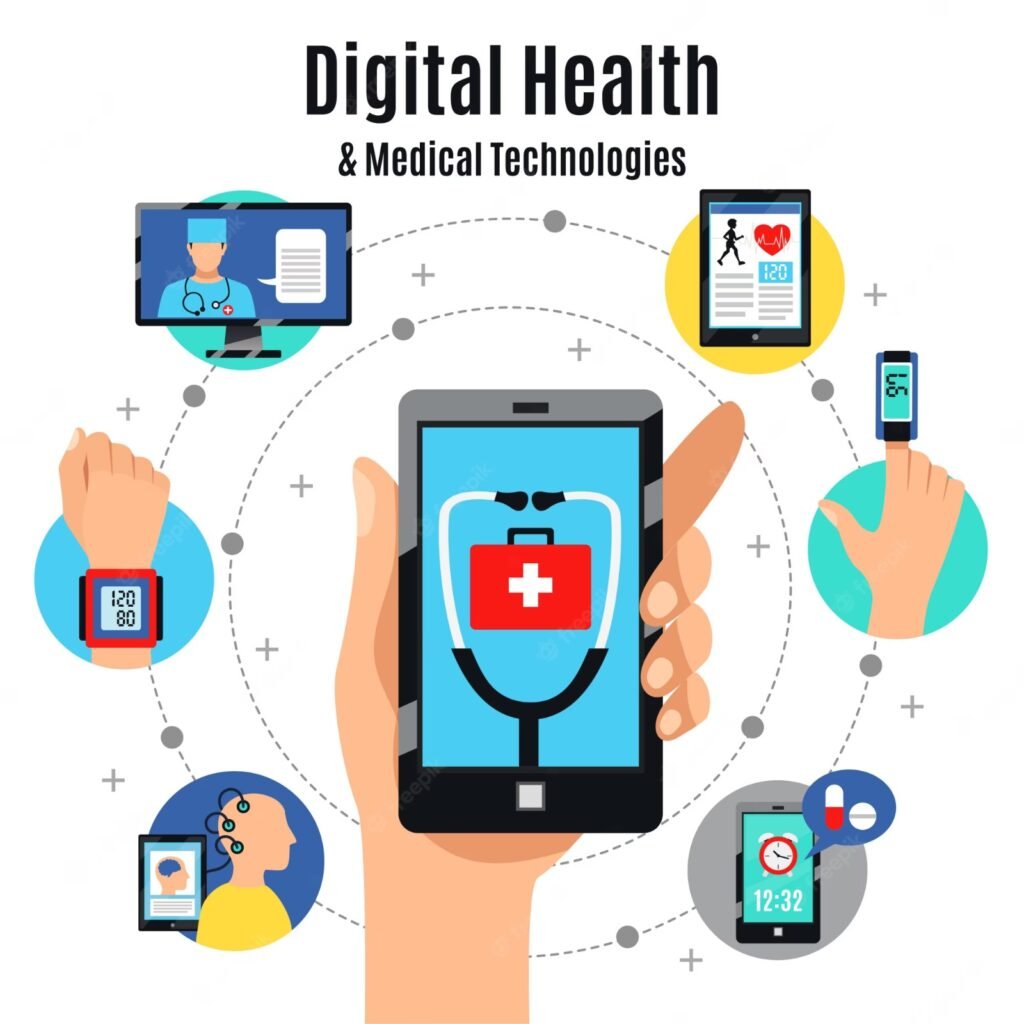
The pharmacy profession is undergoing a rapid digital transformation. With the integration of advanced technology into healthcare, Digital Pharmacy and Telepharmacy are redefining how pharmacists deliver services—making them more accessible, efficient, and patient-centered.
What is Digital Pharmacy?
Digital pharmacy refers to the use of technology to manage, dispense, and monitor medications. It encompasses systems like:
•E-prescriptions (electronic prescriptions)
•Online prescription refills
•Medication management apps
•Automated dispensing systems
Patients can now order their medications online, receive reminders to take them, and track their health data—all from their phones or laptops.
What is Telepharmacy?

Telepharmacy is the remote provision of pharmaceutical care using telecommunications. It enables licensed pharmacists to:
• Review prescriptions
• Counsel patients
• Monitor therapies
• And even supervise dispensing operations from a distance
Originally developed to serve rural or underserved areas, telepharmacy is now expanding globally as a solution to workforce shortages and growing healthcare demands.
How Technology Is Transforming Pharmacy Services
- E-Prescriptions
Reduces errors from illegible handwriting.
Directly links doctors and pharmacies, speeding up the dispensing process.
Provides real-time access to medication histories, reducing duplicate therapies. - Remote Consultations
Patients can speak with pharmacists via video call or messaging apps.
Enhances medication counseling, especially for chronic conditions.
Reduces travel time and waiting periods. - Automated Dispensing Systems
Improves accuracy and efficiency in medication preparation.
Reduces workload and human error in high-volume pharmacies. - Digital Recordkeeping and Inventory
Real-time tracking of drug stocks and expiry dates.
Better compliance with regulations and reduced wastage.
Benefits of Telepharmacy (Especially in Rural Areas)
Telepharmacy offers a range of benefits, particularly in rural and underserved areas where access to healthcare is limited. Here are the key advantages:
- Improved Access to Pharmaceutical Care
• 24/7 Availability: Patients in remote areas can consult with pharmacists anytime via video or phone.
• Overcomes Distance Barriers: Eliminates the need for long travel to the nearest pharmacy, especially important in geographically isolated communities. - Enhanced Medication Safety
• Remote Prescription Review: Licensed pharmacists can review and approve prescriptions digitally to catch potential errors or interactions.
• Real-Time Counseling: Patients still receive one-on-one consultations to ensure they understand how to take their medications correctly. - Cost Efficiency
• Reduced Operational Costs: Smaller clinics or hospitals can provide pharmacy services
without hiring a full-time, on-site pharmacist.
• Lower Patient Expenses: Less travel and fewer missed workdays reduce indirect healthcare costs for patients. - Better Medication Adherence
• Regular Follow-ups: Telepharmacy allows for scheduled virtual check-ins to reinforce adherence and adjust medications as needed.
• Digital Tools: Integration with apps and reminders improves the consistency of medication use. - Expanded Services
• Chronic Disease Management: Pharmacists can help manage conditions like diabetes, hypertension, and asthma remotely.
• Preventive Care: Telepharmacy can support smoking cessation, vaccine consultations, and wellness programs. - Workforce Flexibility
• Efficient Staffing: A single pharmacist can serve multiple remote locations from a central hub, optimizing resources.
• Fills Gaps in Pharmacist Shortages: Helps cover areas that might not otherwise attract or retain pharmacists. - Continuity of Care
• Integrated with Health Systems: Telepharmacy platforms can connect with electronic health records (EHRs) to ensure coordinated care with physicians and other providers.
• Disaster Response: Keeps services running during natural disasters or pandemics when in-person care is disrupted.
Challenges of Telepharmacy
Telepharmacy brings many benefits, especially to underserved areas, but it also comes with several challenges that need to be addressed for successful implementation and sustained operation. Here are the key challenges:
Regulatory and Legal Barriers
• Licensing Issues: Laws vary by state or country, and pharmacists may need to be licensed in each region where they provide services.
• Scope of Practice Limits: Some regions restrict the services a remote pharmacist can provide, such as administering vaccines or counseling.
Technology and Infrastructure Limitations
• Internet Connectivity: Reliable broadband is often lacking in the rural areas that telepharmacy aims to serve.
• System Compatibility: Integration with local pharmacy systems, EHRs, or billing software can be complex and inconsistent.
Patient Privacy and Data Security
• HIPAA Compliance: Ensuring secure communication and data transmission is critical but technically demanding.
• Cybersecurity Risks: Telepharmacy platforms may be vulnerable to data breaches if not properly protected.
Limited Physical Interaction
• Lack of In-Person Services: Some services—like administering injections, blood pressure checks, or physical assessments—can’t be done remotely.
• Reduced Personal Connection: The virtual nature may impact the pharmacist-patient relationship, especially with older or less tech-savvy patients.
Staffing and Training Challenges
• Need for Specialized Training: Staff must be trained not only in pharmacy practice but also in telehealth technology and protocols.
• Monitoring and Supervision: Pharmacy technicians on-site still require oversight, which is harder to manage remotely.
Financial and Reimbursement Issues
• Lack of Insurance Coverage: Some insurers or health systems don’t yet reimburse telepharmacy services at the same rate as in-person care.
• High Initial Costs: Setting up the necessary infrastructure can be expensive, particularly for small clinics.
Patient Engagement and Digital Literacy
• Resistance to Technology: Elderly or less tech-literate patients may struggle with virtual platforms.
• Trust and Adoption: Some patients may doubt the quality of care received remotely compared to in-person visits.
The Future of Digital Pharmacy
The future of telepharmacy is centered around greater accessibility, smarter technology, and expanded services. Key developments include:
• Wider Regulatory Support: Streamlined laws will allow broader use across regions.
• Advanced Tech Integration: AI, wearables, and augmented reality will enhance remote care.
• Personalized Medicine: Genetic data and chronic disease monitoring will enable tailored treatment.
• Expanded Services: From mental health support to medication delivery, telepharmacies will offer more than just dispensing.
• Improved Access and Engagement: Inclusive platforms, mobile units, and patient-friendly apps will reach more people.
• Collaborative Virtual Care: Pharmacists will work closely with other healthcare providers through integrated digital systems.
In short, telepharmacy will evolve into a central component of modern, tech-enabled healthcare, especially in rural and underserved communities.





